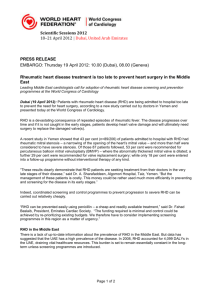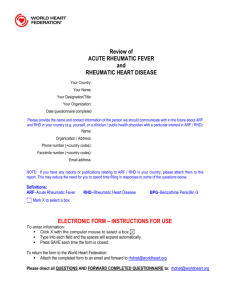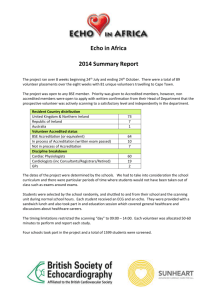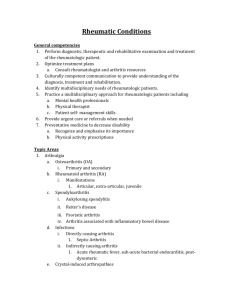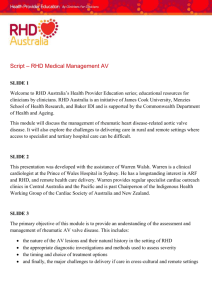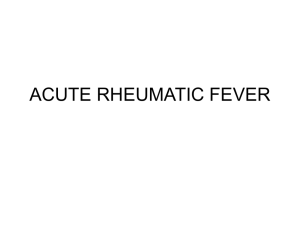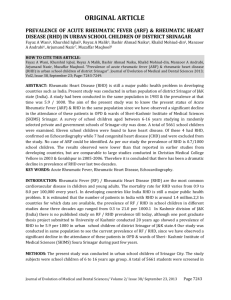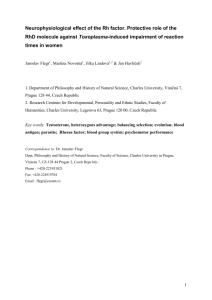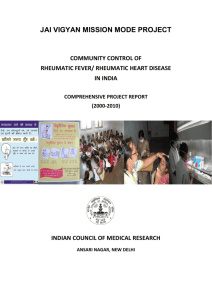Supplementary Data Table 1
advertisement
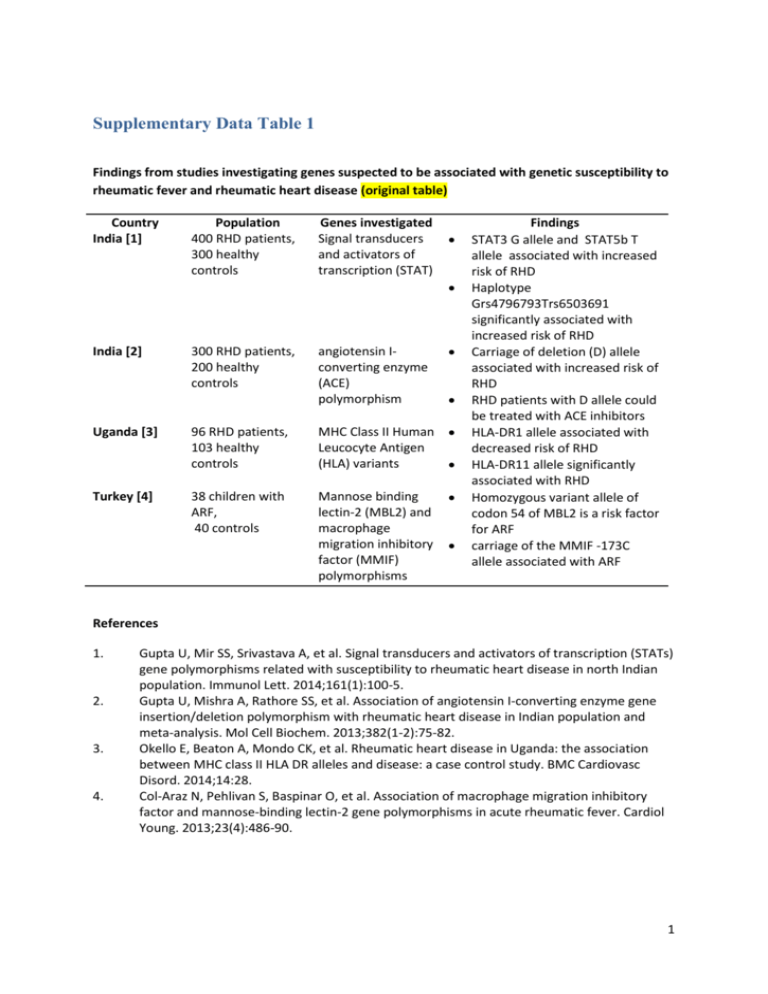
Supplementary Data Table 1 Findings from studies investigating genes suspected to be associated with genetic susceptibility to rheumatic fever and rheumatic heart disease (original table) Country India [1] Population 400 RHD patients, 300 healthy controls Genes investigated Signal transducers and activators of transcription (STAT) India [2] 300 RHD patients, 200 healthy controls angiotensin Iconverting enzyme (ACE) polymorphism Uganda [3] 96 RHD patients, 103 healthy controls MHC Class II Human Leucocyte Antigen (HLA) variants Turkey [4] 38 children with ARF, 40 controls Mannose binding lectin-2 (MBL2) and macrophage migration inhibitory factor (MMIF) polymorphisms Findings STAT3 G allele and STAT5b T allele associated with increased risk of RHD Haplotype Grs4796793Trs6503691 significantly associated with increased risk of RHD Carriage of deletion (D) allele associated with increased risk of RHD RHD patients with D allele could be treated with ACE inhibitors HLA-DR1 allele associated with decreased risk of RHD HLA-DR11 allele significantly associated with RHD Homozygous variant allele of codon 54 of MBL2 is a risk factor for ARF carriage of the MMIF -173C allele associated with ARF References 1. 2. 3. 4. Gupta U, Mir SS, Srivastava A, et al. Signal transducers and activators of transcription (STATs) gene polymorphisms related with susceptibility to rheumatic heart disease in north Indian population. Immunol Lett. 2014;161(1):100-5. Gupta U, Mishra A, Rathore SS, et al. Association of angiotensin I-converting enzyme gene insertion/deletion polymorphism with rheumatic heart disease in Indian population and meta-analysis. Mol Cell Biochem. 2013;382(1-2):75-82. Okello E, Beaton A, Mondo CK, et al. Rheumatic heart disease in Uganda: the association between MHC class II HLA DR alleles and disease: a case control study. BMC Cardiovasc Disord. 2014;14:28. Col-Araz N, Pehlivan S, Baspinar O, et al. Association of macrophage migration inhibitory factor and mannose-binding lectin-2 gene polymorphisms in acute rheumatic fever. Cardiol Young. 2013;23(4):486-90. 1 Supplementary Data Table 2 Joachim clinical decision rules (adapted from [1]) Criteria Points 1 2 3 + number of bacterial signs Age ≤35 months 36-59 months ≥ 60 months Bacterial signs? Tender cervical node Headache Petechia on the palate Abdominal pain Sudden onset (<12 hours) Viral signs Conjunctivitis Coryza Diarrhoea - number of viral signs Total score Bacteriologic diagnosis unavailable ≤2 ≥3 Limited bacteriologic diagnosis available ≤2 3 ≥4 Total score RADT Treatment Symptomatic Antibiotic No Yes No Symptomatic Antibiotic with positive RADT Antibiotic Reference: 1. Joachim L, Jr DC, Smeesters PR. Pragmatic scoring system for pharyngitis in low-resource settings. Pediatr Int. 2010;126(3):e608-14. Supplementary Data Table 3 Recently identified biomarker candidates for the diagnosis of RHD (original table) 2 Biomarker candidate Alpha-1-antichymotrypsin[1] Antibodies against the GAS Group A Carbohydrate [2] CD306 and sCD305 [3] Expected change in RHD patients Reduced Elevated in subclinical RHD cases Collagen metabolism markers and collagen degrading enzymes[4] Desmin[5] Elevated Heat Shock Protein 60[5] Elevated Intercellular adhesion molecule 1 (ICAM-1) vascular cell adhesion molecule 1 (VCAM-1) endothelial selectin (E selectin) [6] Rheumatic carditis with residual lesions > rheumatic carditis no lesions > healthy controls Ischaemia modified albumin [7] PDZ and LIM domain protein 1[5] Elevated in ARF (pre-treatment), normal in RHD Elevated Plasma complement C4-A[1] Protease subunit alpha type-1[5] Elevated Elevated Elevated* Elevated Ratio of T helper 17 cells: regulatory T cells [8] Serotransferrin[1] Tenascin-C [9] Elevated Reduced Reduced in rheumatic carditis (pretreatment) Reduced in severe RHD Elevated in mild and moderate RHD *also elevated in patients with non-rheumatic immune and inflammatory diseases References 1. 2. 3. 4. 5. 6. 7. Gao G, Xuan C, Yang Q, et al. Identification of altered plasma proteins by proteomic study in valvular heart diseases and the potential clinical significance. PLoS ONE. 2013;8(8):1-9. Beaton A, Kabat B, Rippe J, et al. Usefulness of anti-streptococcal antibody profiling for confirmation of latent rheumatic heart disease in asymptomatic Ugandan schoolchildren diagnosed by echocardiography. Poster session presented at: World Congress of Cardiology; 2014 May 4-7; Melbourne. Xie X, Wang C, Xie Y, et al. Development and evaluation of a sandwich ELISA method for the detection of human CD306. J Immunol Methods. 2013;396(1-2):65-73. Banerjee T, Mukherjee S, Ghosh S, et al. Clinical significance of markers of collagen metabolism in rheumatic mitral valve disease. PLoS ONE. 2014;9(3):1-12. Zheng DW, Xu LM, Sun LB, et al. Comparison of the ventricle muscle proteome between patients with rheumatic heart disease and controls with mitral valve prolapse: HSP 60 may be a specific protein in RHD. Biomed Research International. 2014:9. Hafez M, Yahia S, Eldars W, et al. Prediction of residual valvular lesions in rheumatic heart disease: role of adhesion molecules. Pediatr Cardiol. 2013;34(3):583-90. Karatas Z, Baysal T, Sap F, et al. Increased ischaemia-modified albumin is associated with inflammation in acute rheumatic fever. Cardiol Young. 2014;24(3):430-6. 3 8. 9. Bas HD, Baser K, Yavuz E, et al. A shift in the balance of regulatory T and T helper 17 cells in rheumatic heart disease. J Investig Med. 2014;62(1):78-83. Karatas Z, Baysal T, Alp H, et al. Serum tenascin-C: A novel biomarker for diagnosis and predicting prognosis of rheumatic carditis? J Trop Pediatr. 2013;59(6):476-82. 4
